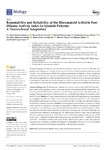Mostrar o rexistro simple do ítem
Repeatability and Reliability of the Rheumatoid Arthritis Foot Disease Activity Index in Spanish Patients: A Transcultural Adaptation
| dc.contributor.author | López-López, Daniel | |
| dc.contributor.author | Martínez-Jiménez, Eva María | |
| dc.contributor.author | Pereiro-Buceta, Héctor | |
| dc.contributor.author | Palomo-López, Patricia | |
| dc.contributor.author | Navarro Flores, Emmanuel | |
| dc.contributor.author | Jiménez-Cebrián, Ana María | |
| dc.contributor.author | Losa Iglesias, Marta Elena | |
| dc.contributor.author | Becerro-de-Bengoa-Vallejo, Ricardo | |
| dc.date.accessioned | 2022-03-17T13:17:07Z | |
| dc.date.available | 2022-03-17T13:17:07Z | |
| dc.date.issued | 2022 | |
| dc.identifier.citation | Martínez-Jiménez, E.M.; Pereiro-Buceta, H.; Palomo-López, P.; Navarro-Flores, E.; Jiménez-Cebrián, A.M.; Losa-Iglesias, M.E.; Becerro-De-Bengoa-Vallejo, R.; López-López, D. Repeatability and Reliability of the Rheumatoid Arthritis Foot Disease Activity Index in Spanish Patients: A Transcultural Adaptation. Biology 2022, 11, 30. https://doi.org/10.3390/biology11010030 | es_ES |
| dc.identifier.uri | http://hdl.handle.net/2183/30048 | |
| dc.description.abstract | [Abstract] Background: The Rheumatoid Arthritis Foot Disease Activity Index (RADAI-F5) questionnaire, based on five questions, is used to assess the severity of rheumatoid arthritis disease in the foot. Nowadays, RADAI-F5 has been validated in different languages; however a Spanish version was lacking. Therefore, the purpose of this research was to translate and validate the Spanish version (RADAI-F5-es). Methods: A cross-cultural translation of the RADAI-F5 questionnaire was performed from English to Spanish. To validate its use, 50 subjects with rheumatoid arthritis who responded to the translated questionnaire two times in an interval of less than 3 months were selected in order to verify the psychometric properties. Results: Excellent agreement between the two versions according to the Cronbach’s α was shown. Five domains with regards to arthritis activity in foot joint tenderness and swelling, foot arthritis pain, general foot health and joint stiffness were added together to obtain the total score. Excellent retest reliability was shown for the total score. Test/retest reliability was excellent for joint stiffness on awakening and foot arthritis pain domains. There were no significant differences among any domains (p > 0.05). There were no statistically significant differences (p = 0.000) for the mean ± standard deviations (SD) between pre- and post-tests (98.09 ± 15.42) [93.75–102.43] and 97.96 ± 13.88 [94.5–101.86] points, respectively). Bland–Altman plots or clinically pertinent variations were not statistically significantly different. Conclusions: The RADAI-F5-es is considered a valid and strong tool with adequate repeatability in the Spanish community | es_ES |
| dc.language.iso | eng | es_ES |
| dc.publisher | MDPI | es_ES |
| dc.relation.uri | https://doi.org/10.3390/biology11010030 | es_ES |
| dc.rights | Atribución 4.0 Internacional | es_ES |
| dc.rights.uri | http://creativecommons.org/licenses/by/4.0/ | * |
| dc.subject | Questionnaire | es_ES |
| dc.subject | Cuestionario | es_ES |
| dc.subject | Artritis crónica | es_ES |
| dc.subject | Arthritis chronic pain | es_ES |
| dc.subject | Pain measurement | es_ES |
| dc.subject | Medida de dolor | es_ES |
| dc.subject | Foot | es_ES |
| dc.subject | Pie | es_ES |
| dc.title | Repeatability and Reliability of the Rheumatoid Arthritis Foot Disease Activity Index in Spanish Patients: A Transcultural Adaptation | es_ES |
| dc.type | info:eu-repo/semantics/article | es_ES |
| dc.rights.access | info:eu-repo/semantics/openAccess | es_ES |
| UDC.journalTitle | Biology | es_ES |
| UDC.volume | 11 | es_ES |
| UDC.issue | 1 | es_ES |
| UDC.startPage | 30 | es_ES |
| dc.identifier.doi | 10.3390/biology11010030 |
Ficheiros no ítem
Este ítem aparece na(s) seguinte(s) colección(s)
-
GI-UDISAP - Artigos [193]






